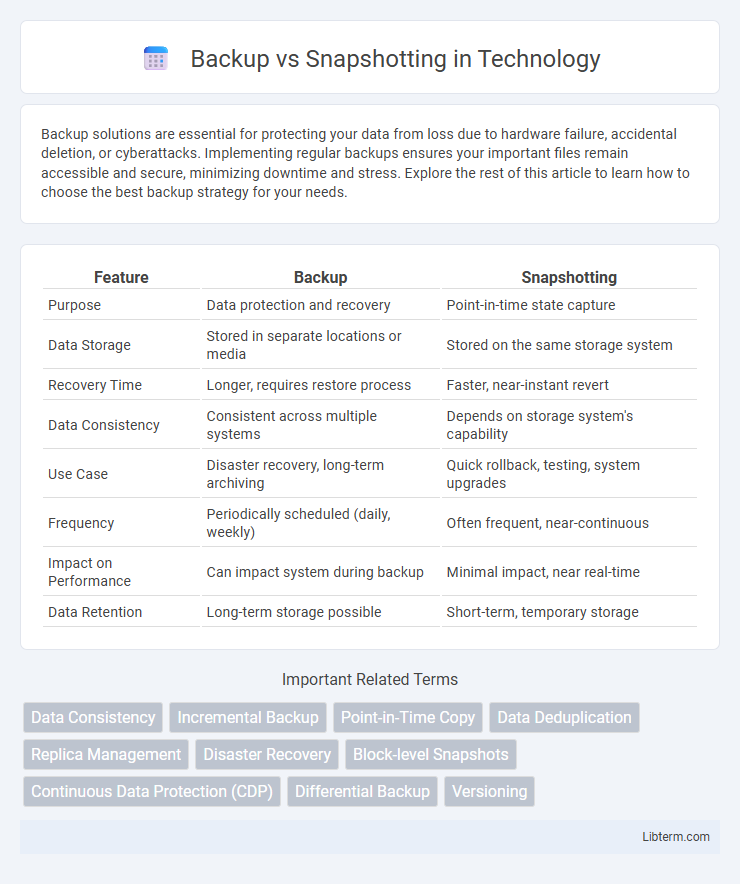Backup solutions are essential for protecting your data from loss due to hardware failure, accidental deletion, or cyberattacks. Implementing regular backups ensures your important files remain accessible and secure, minimizing downtime and stress. Explore the rest of this article to learn how to choose the best backup strategy for your needs.
Table of Comparison
| Feature | Backup | Snapshotting |
|---|---|---|
| Purpose | Data protection and recovery | Point-in-time state capture |
| Data Storage | Stored in separate locations or media | Stored on the same storage system |
| Recovery Time | Longer, requires restore process | Faster, near-instant revert |
| Data Consistency | Consistent across multiple systems | Depends on storage system's capability |
| Use Case | Disaster recovery, long-term archiving | Quick rollback, testing, system upgrades |
| Frequency | Periodically scheduled (daily, weekly) | Often frequent, near-continuous |
| Impact on Performance | Can impact system during backup | Minimal impact, near real-time |
| Data Retention | Long-term storage possible | Short-term, temporary storage |
Introduction to Data Protection: Backup and Snapshotting
Backup and snapshotting are essential data protection techniques designed to safeguard information against loss or corruption. Backups create independent copies of data stored separately, enabling restoration over longer time periods, while snapshots capture the exact state of a system or dataset at a specific moment, typically stored on the same storage system for rapid recovery. Both methods are fundamental in disaster recovery strategies, with backups providing historical data versions and snapshots offering near-instantaneous recovery points.
Understanding Backups: Definition and Types
Backups refer to creating copies of data to protect against loss, corruption, or accidental deletion, ensuring business continuity and data recovery. Common types include full backups, which copy all data; incremental backups, capturing only changes since the last backup; and differential backups, saving changes since the last full backup. Understanding backup types is essential for designing efficient data protection strategies tailored to storage capacity and recovery time objectives.
What is Snapshotting? A Comprehensive Overview
Snapshotting is a data protection technique that captures the state of a system or volume at a specific point in time, enabling quick recovery and minimal downtime. Unlike traditional backups, snapshots are often incremental, storing only changes since the last snapshot, which optimizes storage space and accelerates the restoration process. Commonly used in virtualized environments and storage arrays, snapshotting provides near-instantaneous data preservation without disrupting ongoing system operations.
Key Differences Between Backup and Snapshotting
Backup involves creating a separate, persistent copy of data stored on different media or locations for long-term recovery, while snapshotting captures the state of a system or volume at a specific point in time, typically stored within the same storage system. Backups provide comprehensive data protection with versioning and are essential for disaster recovery, whereas snapshots enable rapid restoration and minimal downtime by leveraging incremental storage techniques. The key differences lie in data portability, storage efficiency, and recovery scope, with backups supporting offsite storage and broader recovery options, while snapshots offer faster, more storage-efficient rollback within the original environment.
Advantages of Traditional Backups
Traditional backups offer comprehensive data protection by creating complete copies of files, enabling full system recovery in case of data loss. They support long-term retention and versioning, allowing restoration from various points in time, which is essential for compliance and archival purposes. Additionally, backups can be stored offsite or in the cloud, providing disaster recovery capabilities beyond the limitations of snapshot storage.
Benefits and Limitations of Snapshotting
Snapshotting offers rapid data capture by creating point-in-time copies of system states, minimizing downtime and storage use compared to traditional backups. Snapshots are ideal for quick recovery and testing environments but depend on underlying storage systems, which may limit their portability and long-term retention. Unlike backups, snapshots often require continuous data integrity and can become less reliable if the source system encounters corruption or hardware failure.
Use Cases: When to Use Backups vs Snapshotting
Backups are essential for long-term data retention, disaster recovery, and restoring data after accidental deletion or corruption, making them ideal for archival and compliance needs. Snapshotting excels in capturing the state of a system or virtual machine at a specific moment, enabling quick rollback and testing without impacting ongoing operations. Use backups when you need complete data restoration over time, and rely on snapshots for short-term, rapid recovery during system updates or software testing.
Performance Impact: Backup vs Snapshotting
Backup processes typically consume higher system resources and longer execution times due to data duplication, affecting performance during active workloads, whereas snapshotting leverages storage-level technology to capture instant, low-impact point-in-time images with minimal I/O overhead. Snapshots reduce downtime and enable rapid recovery but may introduce latency if retention periods are extended or if the underlying storage architecture isn't optimized for high snapshot loads. Backup operations, while more resource-intensive, provide comprehensive data protection and retention capabilities essential for disaster recovery and compliance mandates.
Data Recovery Speed and Reliability Comparison
Backup solutions offer comprehensive data protection with slower recovery times due to full dataset restoration processes, while snapshots provide near-instant recovery by capturing quick point-in-time images of data states. Snapshots excel in speed and minimal performance impact, but their reliability can be limited by storage system integrity and may not protect against data corruption or deletion beyond the snapshot window. Combining backups and snapshots enhances overall data recovery strategies by balancing rapid access with robust data integrity and long-term retention.
Choosing the Right Solution: Backup, Snapshotting, or Both?
Choosing the right data protection strategy depends on specific recovery objectives and system requirements, with backups providing long-term offline storage and snapshots offering rapid point-in-time recovery. Backup solutions excel in disaster recovery and archival needs, preserving full data copies across different locations, while snapshots enable quick restoration and minimal downtime by capturing immediate system states. Combining both methods leverages the strengths of each, ensuring comprehensive data protection with efficient recovery processes and robust version control.
Backup Infographic

 libterm.com
libterm.com